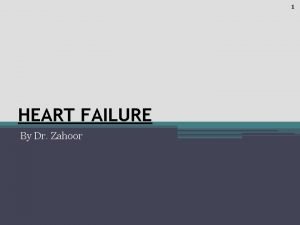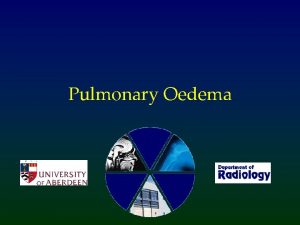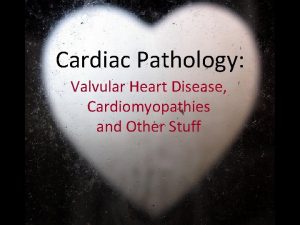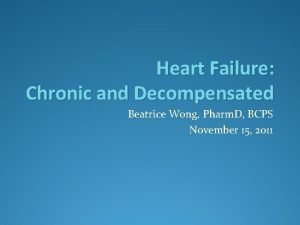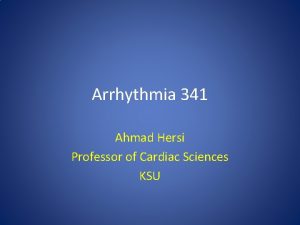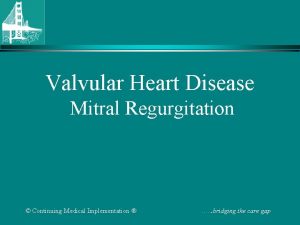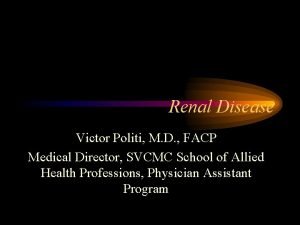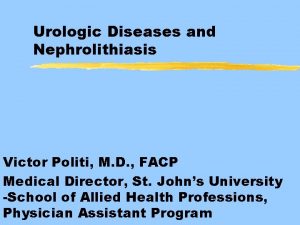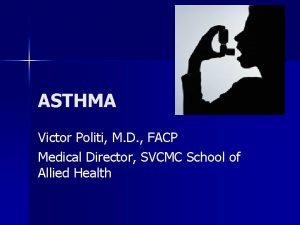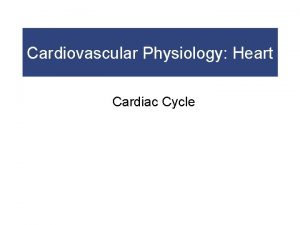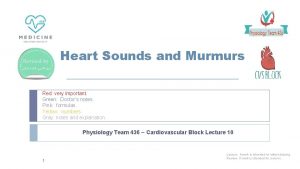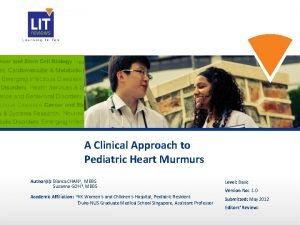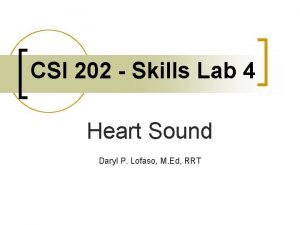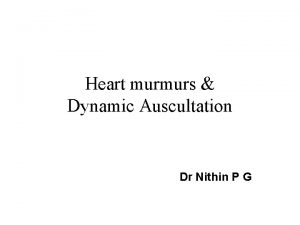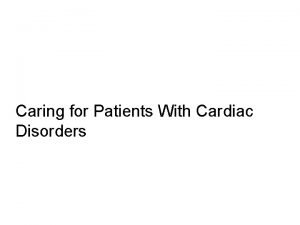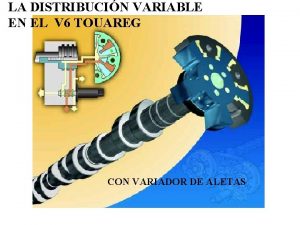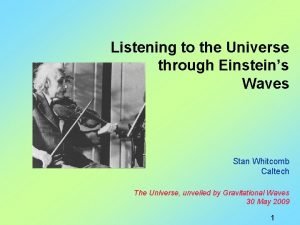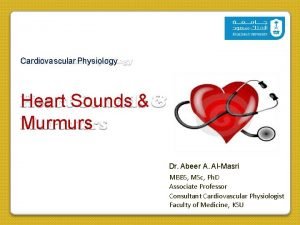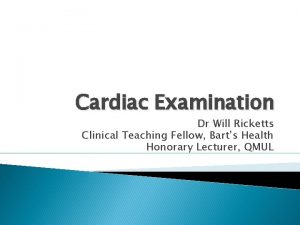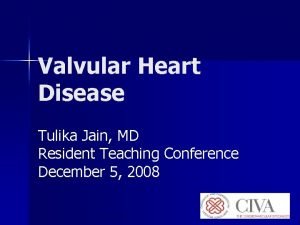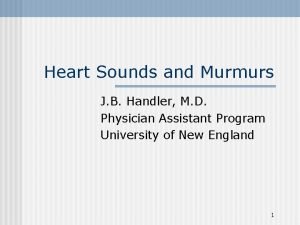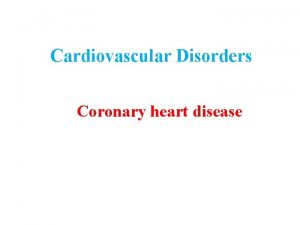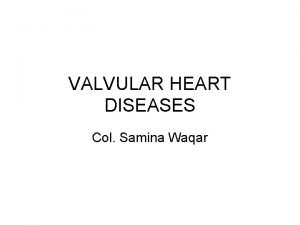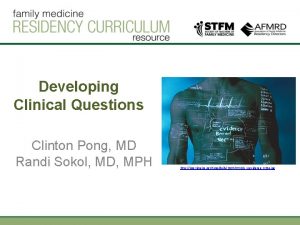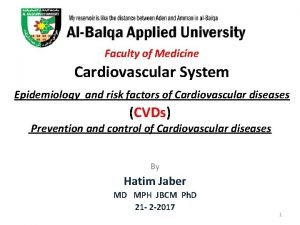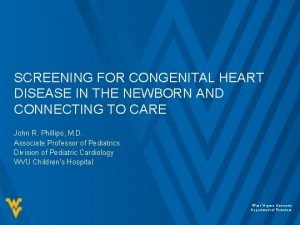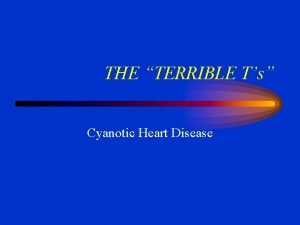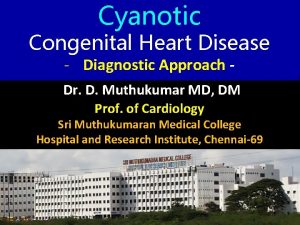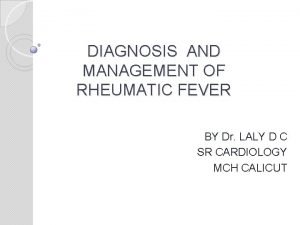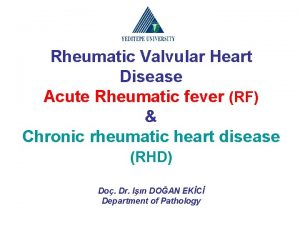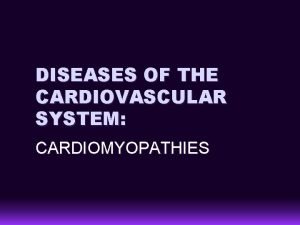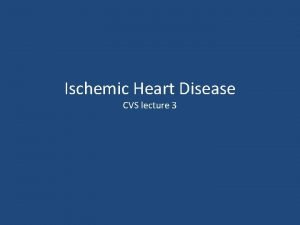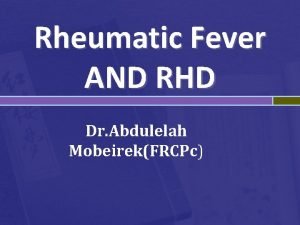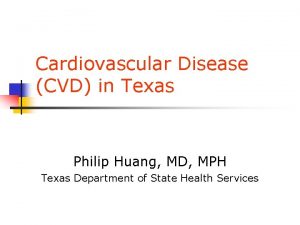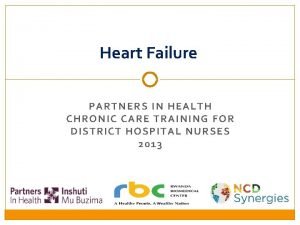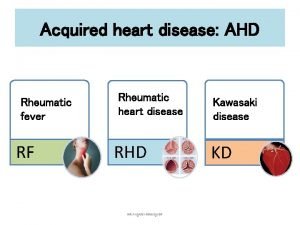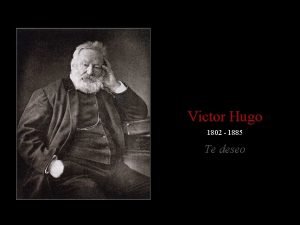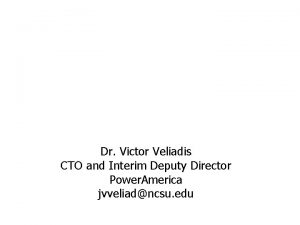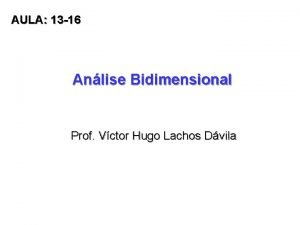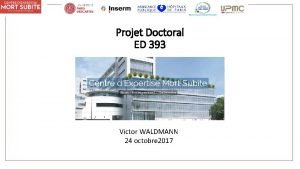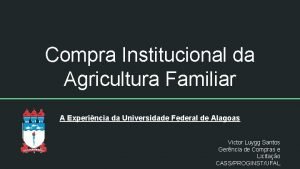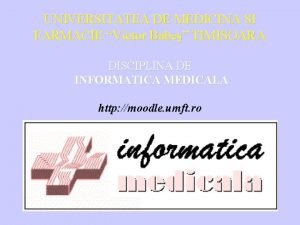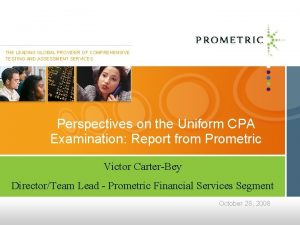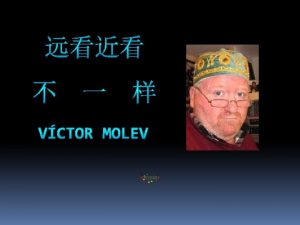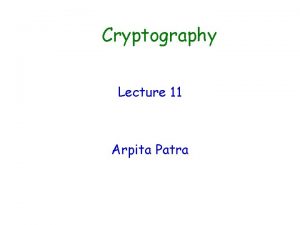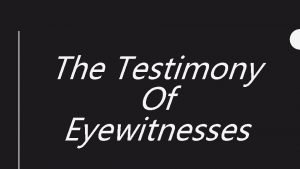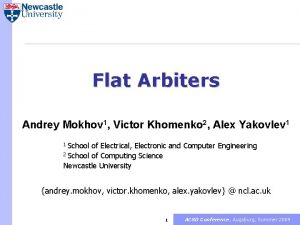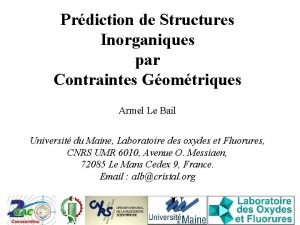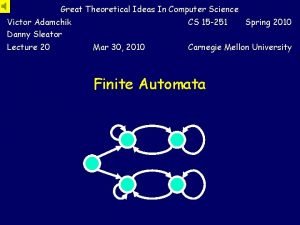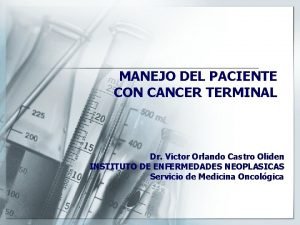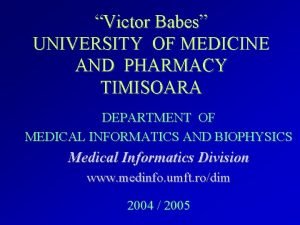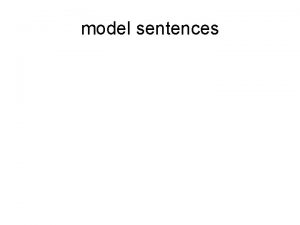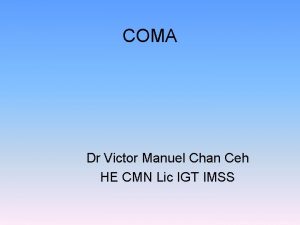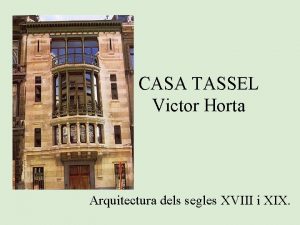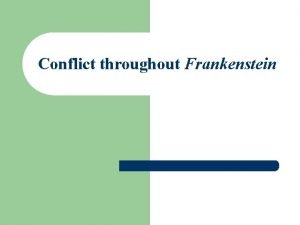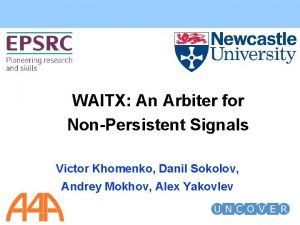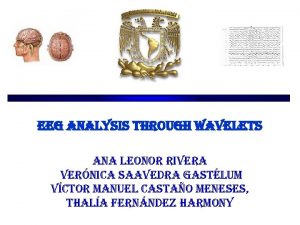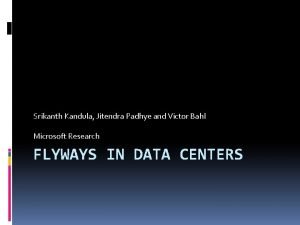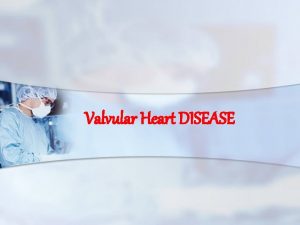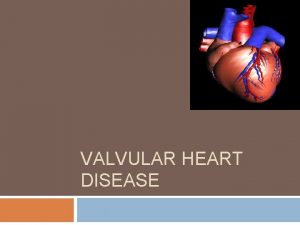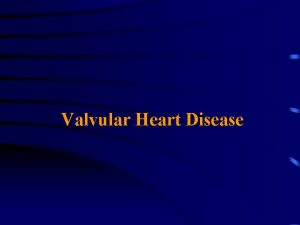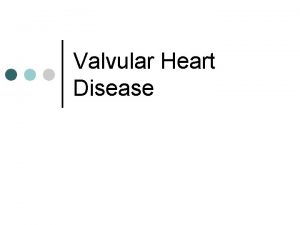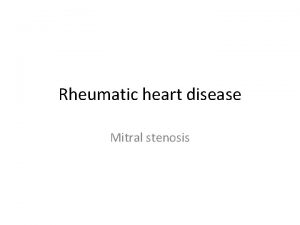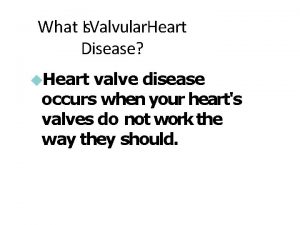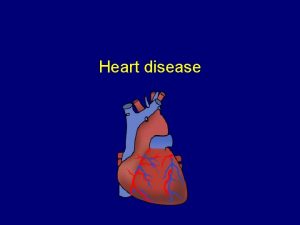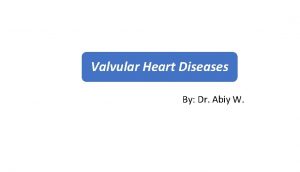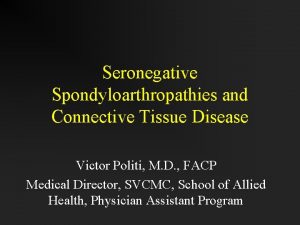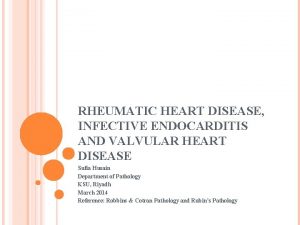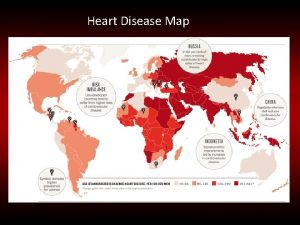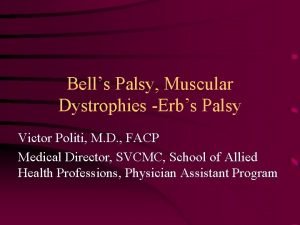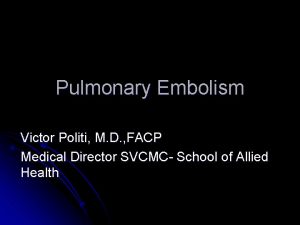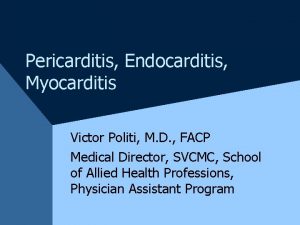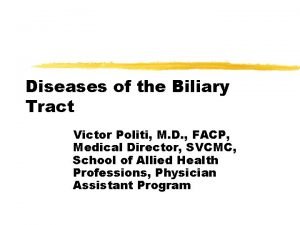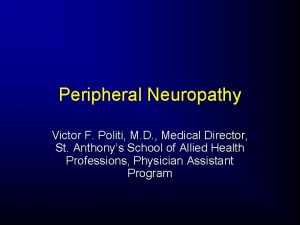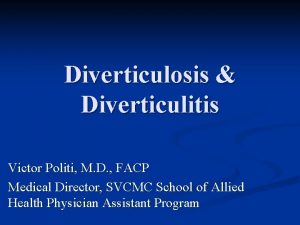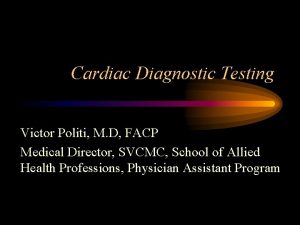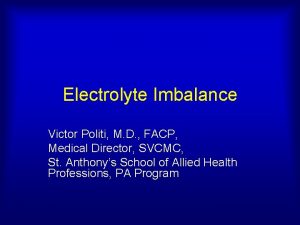Heart Murmurs Valvular Heart Disease Victor Politi M
















































































































- Slides: 112

Heart Murmurs & Valvular Heart Disease Victor Politi, M. D. , FACP Medical Director, SVCMC, School of Allied Health Professions, Physician Assistant Program

What is a Heart Murmur? z. A sound produced as blood flows through the chambers and large blood vessels of the heart during the cardiac cycle of contraction and relaxation.

What is a Heart Murmur? z. The heart beat normally makes two sounds: ythe first is Lub and the second is Dub, these two sounds follow each other (Lub Dub) and are not separated by any extra sounds.

What is a Heart Murmur? z. A heart murmur will be heard as a swishing or a whistling sound in addition to the normal Lub-Dub sound. z. The moving blood sounds like running water in a garden hose.

What is a Heart Murmur? z. A heart murmur is not a diagnosis or disease, it is a sign to alert our attention to check if there is anything wrong. z. Heart murmurs come in different sounds which may help indicate whether the murmur is normal or abnormal.

What is a Heart Murmur? z. Some murmurs are benign or harmless and are more of a finding than a condition. z. A benign murmur is not associated with any significant underlying abnormality of the heart or its vessels.

What is a Heart Murmur? z. Many young people can have benign/innocent flow murmurs and still have normal cardiac structure and function.

What causes a heart murmur? z. Innocent/Benign Murmur Causes: y. Anemia y. Fever y. Venous Hum xa common innocent murmur heard during childhood. This murmur is heard as a soft humming sound at the base of the neck just above the collarbone. It results from the normal blood flow in the large neck veins (jugular veins).

Innocent/benign Causes: Venous Hum z. Light compression of the neck vein will make the murmur transiently disappear, or the murmur will sound louder when turning the child's head to one side or another. z. These simple maneuvers help differentiate a Venous Hum from the murmurs resulting from heart disease.

Innocent/benign Causes: Still’s Murmur z This heart murmur is named after the doctor who described it. z It is heard most frequently in active, healthy 3 to 7 -year old children. z The murmur represents the normal sound of blood gushing out into the aorta during heart contraction. z It has a musical tone to it and thus is frequently described as "musical murmur"; it usually sounds softer during sitting and may sound very loud during fever, anxiety, or exercise.

Still’s Murmur

Pathologic Murmur z. A pathologic heart murmur is one associated with a structural or functional abnormality of the heart.

Pathologic Murmurs z. Narrow Valve- stenosis z. Valve insufficiency/regurgitation z. Septal defects- Hole in the Heart

Valve insufficiency/regurgitation z As the heart valve closes some blood leaks back making a blowing sound. z A leaking valve is called insufficient or regurgitating. z Its importance depends on how much blood is leaking, what valve is involved, and how long it has been going on.

Septal defects – hole in heart y. If the pressure in the heart chambers is not the same, the blood will flow from the high to the lowpressure chamber, producing a murmur sounding like a waterfall. y. If the hole is small, it will make a very loud sound. y. If the hole is large it may make a faint murmur that may go unnoticed for some time; therefore a faint murmur may sometimes indicate a serious problem.

Septal defects – hole in heart z. If it is between the upper cardiac chambers, it is called Atrial Septal Defect (ASD), and is called Ventricular Septal Defect (VSD) if it is between the lower cardiac chambers. z. The importance of septal defects depends on their size and site.

Mechanisms of Heart Murmurs z. Most murmurs are produced as blood flows past the cardiac valves, which separate the chambers of the heart, or through the valves that lead to the great vessels of the lungs and the systemic circulation.

Mechanisms of Heart Murmurs z They are usually caused by one of the following mechanisms: y. Flow across partial obstruction (e. g. aortic stenosis) y. Flow across valvular or intravascular irregularity w/o obstruction (e. g. bicuspid aortic valve w/o true stenosis) y. Increased flow through normal structures (e. g. aortic systolic murmur associated w/anemia)

Mechanisms of Heart Murmurs y. Flow into dilated chamber (e. g. aortic systolic murmur associated w/aneurysmal dilatation of the ascending aorta) y. Backward or regurgitant flow across an incompetent valve or defect (e. g. mitral regurgitation) y. Shunting of blood out of a high pressure chamber or artery through abnormal passage (e. g. ventricular septal defect)

Midsystolic Ejection Murmurs z Most common type of murmur z May be: y 1. Organic x(i. e. secondary to structural cardiovascular abnormality) y 2. Functional x(i. e. secondary to a physiologic alteration w/or w/o heart dx) y 3. Innocent x(i. e. not associated with any functional or structural abnormality)

Midsystolic Ejection Murmurs z. Organic causes include: y. Aortic stenosis y. Pulmonoic stenosis

Pansystolic Regurgitant Murmurs z. Heard when blood flows from a chamber of high pressure to one of lower pressure through a valve or other structure that should be closed. z. Regurgitation (incompetence or insufficiency) means there is a leak!

Pansystolic Regurgitant Murmurs z. The murmur begins immediately with the 1 st heart sound and continues up to the 2 nd heart sound. z. Causes include: y. Mitral regurgitation LV LA y. Tricuspid regurgitation RV RA y. Ventricular septal defect LV RV

Diastolic Murmurs z Unlike systolic murmurs, diastolic murmurs are almost always indicative of heart disease. z Two general types may be distinguished: y. The diastolic rumble originating in atrioventricular valves y. The early diastolic murmurs of semilunar valve incompetence

Diastolic Murmurs z. Diastolic rumbling murmurs are caused by: y. Flow across distorted or stenotic mitral or tricuspid valves y. Increased blood flow across normal mitral or tricuspid valves

Diastolic Murmurs z. Because these valves open only after the aortic and pulmonic valves close, a short period of silence separates S 2 from the beginning of diastolic rumbles. z. These murmurs are low in pitch, rumbling in quality, and heard best with the bell of the stethoscope in light skin contact.

Diastolic Murmurs z. Semilunar valve incompetence may result either from valvular deformity or from dilatation of the valvular ring. z. In either case blood regurgitates from the great vessel back into the ventricle.

Diastolic Murmurs z Murmurs of aortic regurgitation, together with most murmurs of pulmonic regurgitation, start immediately after the second sound and then diminish in intensity z In contrast to the rumbling atrioventricular valve murmurs, they are high pitched and blowing and best heard with the diaphragm pressed firmly on the chest.

Diastolic Murmurs z. The most common examples of these two types of diastolic murmurs are: y. Mitral stenosis y. Aortic regurgitation

Points to Remember ! z If the flow is excessive or turbulent, a murmur may be manifest. z Blood flowing through a tight valve will produce a murmur. z Blood that is leaking back across an improperly sealing valve also can cause a murmur. z Occasionally, abnormal communications (holes) between chambers of the heart can result in the presence of a murmur.

Diagnosing a Murmur z. Diagnosing a heart murmur begins with auscultation of the heart. z. The location, quality, pitch and variation in the sound are all important clues to whether the murmur is benign or pathologic.

Murmur Evaluation z. One of the most useful tests in evaluating a murmur is an echocardiogram. z. Other tests – y. EKG y. Chest x-ray


Valvular Heart Disease z 90% of valvular disease is chronic, with decades between the onset of the structural abnormality and symptoms

z. The four heart valves prevent retrograde flow of blood during the cardiac cycle, allowing efficient ejection of blood with each contraction of the cardiac chambers


z. The mitral valve has two cusps, while the other three heart valves normally have three cusps

z. The right and left papillary muscles promote effective closure of the tricuspid and mitral valves, respectively.

Valvular Heart Disease z. Mitral Stenosis z. Mitral Regurgitation z. Aortic Stenosis z. Aortic Regurgitation z. Tricuspid Stenosis z. Tricuspid Regurgitation


Mitral Stenosis

Mitral Stenosis. Pathophysiology z. Despite its declining frequency, rheumatic heart disease is still the most common cause of mitral valve stenosis z. Due to progressive dilation of the atria, many patients with mitral stenosis will go on to develop atrial fibrillation

Mitral Stenosis z. Normal mitral valve 4 -6 cm 2 z. When the valve narrows <1. 5 cm 2, left atrial pressure must rise to maintain normal flow across the valve and a normal cardiac output z. This results in a pressure difference between the left atrium and the left ventricle during diastole

Mitral Stenosis z. In mild cases of mitral stenosis, the patient may be asymptomatic and cardiac output and left atrial pressure may be normal z. In moderate cases (valve area < 1. 5 cm 2) as left atrial pressure rises - dyspnea and fatigue appear

Mitral Stenosis z. With severe stenosis, pulmonary venous congestion at rest and reduced cardiac output occur resulting in dyspnea, fatigue, and right sided heart failure

Mitral Stenosis Clinical Findings z. Dyspnea y. In 80% of cases, most common presenting symptom y. Paroxysmal nocturnal dyspnea zhemoptysis y 2 nd most common symptom z. Orthopnea z. Symptoms often precipitated by onset of pregnancy or atrial fibrillation

Mitral Stenosis Clinical Findings z. Murmur yduration varies - severity of stenosis & heart rate ymiddiastolic rumble, crescendos into S 2 z. Heart Sounds ylong snapping S 1 yapical impulse is small and tapping due to underfilled left ventricle

Mitral Stenosis - Murmur z. The pressure gradient and the length of the diastolic murmur reflect the severity of mitral stenosis

Mitral Stenosis Diagnostic Studies z. Echocardiography yreveals thickened valve that opens poorly, closes slowly yrather than moving in opposite directions, the anterior and posterior leaflets are fixed, moving together yrule out atrial myxoma (clinical presentation similar to mitral stenosis) yleft atrial size can be accurately measured xincreased size - increased risk of atrial fibrillation


Mitral Stenosis Diagnostic Studies z. ECG ymay show notched or diphasic P waves and right axis deviation z. X-ray yearly finding- straightening of left heart border (left atrial enlargement) ysubsequent findings - pulmonary congestion, redistribution of flow to upper lung fields, Kerley B lines, along with an increase in vascular markings

Kerley B lines are short, horizontal linear radiopacities at the periphery of the lung that represent thickened, interlobular septa

Mitral Stenosis Treatment z. Warfarin anticoagulation - after A-Fib z. Surgery - indications yuncontrolled pulmonary edema ylimiting dyspnea & intermittent pulmonary edema ypulmonary HTN w/right ventricular hypertrophy or hemoptysis ylimitation of activity despite ventricular rate control/medical therapy yrecurrent systemic embolic despite anticoagulation w/moderate-severe stenosis

Mitral Stenosis Treatment z. Open mitral commissurotomy ypatients w/o substantial mitral regurgitation z. Valve replacement surgery yindicated when combined stenosis and insufficiency are present or when the mitral valve is so distorted and calcified that a satisfactory valvulotomy is impossible

Mitral Stenosis z. Prosthetic valves y. Warfarin anticoagulant therapy required - usually for at least initial 3 months with bioprosthesis - if atrial fibrillation persists - anticoagulation therapy should continue ypossible problems xthrombosis xparavalvular leak xendocarditis xdegenerative changes in tissue valves

Mitral Stenosis Treatment z. Balloon valvuloplasty yeffective in patients w/o mitral regurgitation and in cases where valve calcification is not excessive

Mitral Regurgitation (Mitral Insufficiency) (Mitral Incompetence)

Mitral Regurgitation z. The mitral leaflets do not close normally during left ventricular systole, blood is ejected into the left atrium as well as through the aortic valve zthis results in increased volume load on the left atria

Mitral Regurgitation z. Mitral Regurgitation leads to left atrial enlargement - subsequently resulting in atrial fibrillation

Mitral Regurgitation z. Case presentation varies depending upon the speed with which the condition develops z. In acute cases, left atrial pressure elevates abruptly ycan result in pulmonary edema if severe

Mitral Regurgitation z. Acute cases y. Typically, patient presents with dyspnea, tachycardia, and pulmonary edema y. ECG-may show evidence of acute inferior wall infarction (more common than anterior wall) yabsent to minor calcification of mitral valve yno stenosis, little left ventricle dilation y. X-ray-minimally enlarged left atrium, pulmonary edema - from papillary muscle rupture

Mitral Regurgitation z. In chronic cases, the left atrium dilates, left atrial pressure rises little, even with large regurgitant flow yslowly progressive- years to decades yexertional dyspnea (1 st symptom), and fatigue that progress gradually over years ypressure in the pulmonary veins show a transient rise during exercise y. ECG-may demonstrate LVH yx-ray-left ventricular/atrial enlargement in

Mitral Regurgitation z. Intermittent cases ytypically present with acute episodes of respiratory distress due to pulmonary edema ycan be asymptomatic between attacks

Mitral Regurgitation z. Many causes yrheumatic disease ymyxomatous degeneration (mitral valve prolapse) yconnective tissue disease (Marfan's syndrome) yinfective endocarditis ycardiac tumors (myxoma) - rare cause

Mitral Regurgitation z. Nonrheumatic mitral regurgitation may develop suddenly after MI, valve perforation in infective endocarditis, or ruptured chordae tendineae in MVP z. Inferior MI due to right coronary occlusion is the most common cause of ischemic mitral valve incompetence

Mitral Regurgitation z. Rheumatic heart disease is the most common cause of chronic mitral incompetence

Mitral Regurgitation z. Appetite suppressant drugs (fenfluramine and phentermine, or dexfenfluramine) have been associated with cardiac valve incompetence

Mitral Regurgitation z. Murmur y. Acute; harsh apical systolic murmur, begins with S 1, may end before S 2 z. Heart Sounds y. S 1 and S 2 are heard


Mitral Regurgitation Diagnostic Studies z. Echocardiography z. TEE z. Nuclear Medicine/MRI z. Cardiac Cath

MVP z. Click-murmur syndrome z. Etiology unknown - possibly congenital z. Usually asymptomatic z. May be associated with ynonspecific chest pain ydyspnea yfatigue ypalpitations

MVP z. Characteristic midsystolic click ymay be multiple, often followed by late systolic murmur yaccentuated in standing position z. Most commonly affects women y 10% of cases - healthy young women ymany thin ysome with minor chest wall deformities

MVP z. Usually no sequelae if only midsystolic click present zsignificant mitral regurgitation may develop in cases with late or pansystolic murmur (due to rupture of chordae tendineae)

MVP z. Need for valve replacement yincreases with age ymen more than women require surgery y 2% of patients over age 60 with significant regurgitation require surgery z. To reduce risk of endocarditis - antibiotic prophylaxis prior to dental work or surgery

MVP z. Aggressive management necessary in cases of symptomatic ventricular tachycardia z. Diagnosis primarily clinical - can be confirmed by echocardiogram

MVP z. With MVP there is an increased incidence of - ysudden death ydysrhythmias y. TIA for persons under age 45

MVP z. In cases of MVP w/o mitral regurgitation at rest, exercise provokes mitral regurgitation in 32% of patients zthis is a predictor for a high risk of morbid events

Mitral regurgitation due to papillary muscle dysfunction/MI z. Mitral regurgitation may subside as left ventricular dilatation diminishes or the infarction heals z. Transient (sometimes severe) regurgitation may occur after an MI z. In cases of persistent severe regurgitation, poor prognosis with or w/o surgery

Secondary Mitral Regurgitation z. Papillary muscle dysfunction or dilation of the mitral annulus in patients with dilated cardiomyopathy of any origin z. Valve replacement generally contraindicated due to poor risk: benefit ratio z. However, valve replacement in cases where the Left EF >30% have shown good result in some studies

Aortic Stenosis

Aortic Stenosis z. Blood flow into the aorta is obstructed, producing progressive LVH and low cardiac output z. Most commonly, this is caused by progressive valvular calcification y. In younger patients with congenital bicuspid valve y. In the elderly with normal three-cusp valves

Aortic Stenosis z. In the elderly the aortic valve becomes increasingly sclerotic and eventually stenotic z. Degenerative valve disease is three -four times more frequent in men than women z. More common in smokers and hypertensives

Aortic Stenosis z. Congenital heart disease - ymost common cause z. Rheumatic heart disease ysecond most common cause zdegenerative heart disease (calcific aortic stenosis) y 3 rd most common cause overall y. Most common cause > age 70

Aortic Stenosis z. Treatment ysurgery is indicated in all symptomatic patients yexceptions xdeclining left ventricular function xvery severe left ventricular hypertrophy xvery high gradients xseverely reduced valve areas

Aortic Stenosis z. Anticoagulation with warfarin is required for mechanical prostheses but not essential with bioprosthesis zbioprosthetic valves undergo degenerative changes and usually require replacement with 7 -10 years - newer ones may be more resilient

Aortic Stenosis z. Ross procedure yswitching the patient’s pulmonary valve to the aortic position, placing a bioprosthesis in the pulmonary position y(bioprosthesis do not deteriorate as fast on the right side of the heart) y. This procedure has produced excellent results without anticoagulation

Aortic Stenosis z. Percutaneous balloon valvuloplasty yshort term reduction in severity yrestenosis recurs rapidly in most adults with calcified valves yused on poor candidates for surgery or to stabilize high risk patients prior to surgery

Aortic Stenosis z. Classic triad of symptoms ydyspnea ychest pain ysyncope

Aortic Stenosis z. Dyspnea is usually the first symptom, followed by paroxysmal nocturnal dyspnea, syncope on exertion, angina, and MI

Aortic Stenosis z. Sudden death, usually from a dysrhythmia, occurs in 25% of cases zx-ray- early on - normal, eventually LVH and findings of CHF are evident if the valve is not replaced z. ECG-demonstrates criteria for LVH, left or right bundle branch block is also present in 10% of cases

Aortic Stenosis z. Murmur - yharsh systolic ejection murmur z. Heart sounds yparadoxic splitting of S 2, S 3, and S 4 may be present; pulse of small amplitude; pulse has a slow rise and sustained peak


Aortic Regurgitation (Chronic Regurgitation) (Aortic Incompetence)

Aortic Regurgitation z 20% of cases acute in nature z. Infective endocarditis - accounts for majority of cases zaortic dissection at the aortic root causes the remainder of cases

Aortic Regurgitation z. In acute cases, sudden increase in backflow of blood into the ventricle raises left ventricular end diastolic pressure, which may cause acute heart failure z. Rheumatic heart disease and congenital disease cause the majority of chronic cases

Aortic Regurgitation z. In acute disease ydyspnea most common presenting symptom (50% of cases) ymany cases have acute pulmonary edema with pink frothy sputum yfever, chills - if endocarditis cause

Aortic Regurgitation z. Dissection of the ascending aorta typically produces a tearing chest pain - may radiate between the shoulders z. ECG changes w/aortic dissection - ischemia or findings of acute inferior MI - suggestive of right coronary artery involvement

Aortic Regurgitation z. Chest xray- in acute state demonstrates acute pulmonary edema with less cardiac enlargement than expected

Aortic Regurgitation z. In chronic disease, ythe ventricle progressively dilates to accommodate the regurgitant blood volume y. Marked peripheral vasodilation

Aortic Regurgitation z. Chronic regurgitation y 1/3 of patients have palpitations associated with a large stroke volume and/or premature ventricular contractions y. Frequently, these sensations are noticed in bed

Aortic Regurgitation z. Chronic Regurgitation ywide pulse pressure with prominent ventricular impulse ywater hammer pulse may be noted (peripheral pulse that has a quick rise in upstroke followed by peripheral collapse)

Aortic Regurgitation z. Murmur yhigh pitched blowing diastolic murmur immediately after S 2 z. Heart Sounds y. S 3 may be present; wide pulse pressure

Aortic Regurgitation z. An association between the appetite suppressant drugs (fenfluramine and phentermine or dexfenfluramine) has also been found for aortic incompetence

Tricuspid Stenosis z. Usually rheumatic in origin zshould be suspected when right heart failure appears in course of mitral valve disease - marked by hepatomegaly, ascites, and dependent edema z. May also occur in carcinoid syndrome

Tricuspid Stenosis z. Typical diastolic rumble along lower left sternal border mimics mitral stenosis zin sinus rhythm, a presystolic liver pulsation noted z. Echocardiography & doppler z. Cardiac Cath - diagnositic

Tricuspid Stenosis z. Surgical options yvalvotomy yprosthetic valve replacement yballoon valvuloplasty (experience limited) may be initial procedure

Tricuspid Regurgitation z. Right ventricle overload - result of left ventricular failure of any cause zoccurs in conjunction with right ventricular and inferior MI z. IV drug users - tricuspid valve endocarditis and regurgitation common

Tricuspid Regurgitation z. Other causes ycarcinoid syndrome ylupus erythematosus ymyxomatous degeneration of the valve (associated with MVP) y. Ebstein’s anomaly

Tricuspid Regurgitation z. Signs/symptoms yidentical to those of right ventricular failure y. In presence mitral valve disease xearly onset right heart failure xharsh systolic murmur - lower left sternal border - (separate from mitral murmur)

Tricuspid Regurgitation z. Prominent regurgitant systolic v wave in right atrium and jugular venous pulse zregurgitant wave, systolic murmur increased with inspiration z. Inspiratory S 3 may be present zwhen secondary to mitral valve disease or other left sided disease my regress when underlying disease corrected

Tricuspid Regurgitation z. Surgical repair yvalve repair or valvuloplasty of tricuspid ring preferred to valve replacement

Questions ? ?
 Causes of valvular heart disease
Causes of valvular heart disease Lvvo heart
Lvvo heart Nursing assessment for congestive heart failure
Nursing assessment for congestive heart failure Upper lobe venous diversion
Upper lobe venous diversion Pathophysiology of valvular heart disease
Pathophysiology of valvular heart disease Causes of valvular heart disease
Causes of valvular heart disease Causes of valvular heart disease
Causes of valvular heart disease Mitral regurgitation symptoms
Mitral regurgitation symptoms Pathophysiology of valvular heart disease
Pathophysiology of valvular heart disease Dr victor politi
Dr victor politi Victor politi
Victor politi Victor politi
Victor politi Victor politi
Victor politi Cardiac output and heart rate
Cardiac output and heart rate Diastolic murmur
Diastolic murmur Tetralogy of fallot heart sounds
Tetralogy of fallot heart sounds Heart murmurs
Heart murmurs Murmur that increases with valsalva maneuver
Murmur that increases with valsalva maneuver Prinivil
Prinivil Rachel politi
Rachel politi Traslape valvular
Traslape valvular Communicable disease and non communicable disease
Communicable disease and non communicable disease Wave could hear murmurs across universe
Wave could hear murmurs across universe Murmur intensity grading
Murmur intensity grading Giant gravitational detectors hear murmurs across
Giant gravitational detectors hear murmurs across Normal apex beat
Normal apex beat Tulika jain
Tulika jain Giant wave detectors murmurs universe
Giant wave detectors murmurs universe Heart auscultation points
Heart auscultation points Rheumatic heart disease causes
Rheumatic heart disease causes Coronary heart disease
Coronary heart disease Samina waqar
Samina waqar Randi sokol
Randi sokol Heart disease and stroke are the world's biggest killers
Heart disease and stroke are the world's biggest killers Congenital heart disease pda
Congenital heart disease pda Knee chest position
Knee chest position Heart disease
Heart disease 5 terrible ts
5 terrible ts Differential cyanosis
Differential cyanosis Chronic rheumatic heart disease
Chronic rheumatic heart disease Heart disease
Heart disease Classification of antianginal drugs
Classification of antianginal drugs Feline
Feline /watch?v=0evgft8hgns
/watch?v=0evgft8hgns Pathophysiology of ischemic heart disease
Pathophysiology of ischemic heart disease Ronaldo heart disease
Ronaldo heart disease Modern treatment of heart disease
Modern treatment of heart disease Strepsore
Strepsore Mitral facies
Mitral facies Heart disease data
Heart disease data Nyha class 분류
Nyha class 분류 Beau's lines autoimmune disease
Beau's lines autoimmune disease Tetralogy of fallot
Tetralogy of fallot Heart 2 heart
Heart 2 heart Third heart sound
Third heart sound Goat heart dissection
Goat heart dissection Victor hugo te deseo
Victor hugo te deseo Desejo primeiro que você ame e que amando victor hugo
Desejo primeiro que você ame e que amando victor hugo Victor petrini trasaturi morale
Victor petrini trasaturi morale Victor hurtig
Victor hurtig Eruditio didascalia, de hugo de san victor
Eruditio didascalia, de hugo de san victor Victor adamchik
Victor adamchik Victor veliadis
Victor veliadis Tabela bidimensional
Tabela bidimensional Ed 393
Ed 393 Victor adamchik
Victor adamchik Vector victor meaning
Vector victor meaning Victor le grand
Victor le grand Victor pestov
Victor pestov Preenchida
Preenchida Casa doru victor babes
Casa doru victor babes Victor hugo intro
Victor hugo intro Edith frank
Edith frank Universitatea de medicină și farmacie victor babeș
Universitatea de medicină și farmacie victor babeș Victor carter-bey
Victor carter-bey Victor hugo spectacle rassurant
Victor hugo spectacle rassurant Victor vasarely self portrait
Victor vasarely self portrait Fue la primera mano que rozó mi piel
Fue la primera mano que rozó mi piel Victor shoup
Victor shoup Vitrac
Vitrac Who is father vicente balaguer
Who is father vicente balaguer Magic ink bret victor
Magic ink bret victor Victor khomenko
Victor khomenko Victor e. cabrera
Victor e. cabrera Victor prdiction
Victor prdiction Víctor alfonso téllez rizcala
Víctor alfonso téllez rizcala Georges jules victor clairin
Georges jules victor clairin Victor adamchik
Victor adamchik Dr victor de moya
Dr victor de moya Victor castro oliden
Victor castro oliden Quando observamos da praia um veleiro
Quando observamos da praia um veleiro Victor little league
Victor little league Voici que la saison victor hugo
Voici que la saison victor hugo Victor hugo desejo
Victor hugo desejo Poema te deseo de victor hugo
Poema te deseo de victor hugo Victor le maladroit
Victor le maladroit Victor babeş university of medicine and pharmacy
Victor babeş university of medicine and pharmacy Desejo victor hugo
Desejo victor hugo Dr viktor christiansen
Dr viktor christiansen Astrologus victor
Astrologus victor Victor hugo knihy
Victor hugo knihy Jesus adrian romero wiki
Jesus adrian romero wiki Victor hugo te deseo wikipedia
Victor hugo te deseo wikipedia Victor chan
Victor chan Victor horta casa tassel
Victor horta casa tassel La casa tassel
La casa tassel Chapter 5 frankenstein summary
Chapter 5 frankenstein summary Conflicts in frankenstein
Conflicts in frankenstein Chloe and delgado
Chloe and delgado Waitx
Waitx Victor farinelli
Victor farinelli Victor manuel castaño
Victor manuel castaño Jitendra padhye
Jitendra padhye
